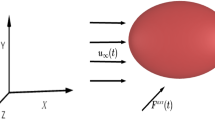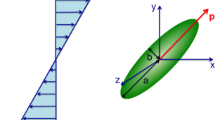Abstract
A numerical technique for the dynamical simulation of three-dimensional rigid particles in a Newtonian fluid is presented. The key idea is to satisfy the no-slip boundary condition on the particle surface by a localized force-density distribution in an otherwise force-free suspending fluid. The technique is used to model the sedimentation of prolate spheroids of aspect ratio b/a=5 at Reynolds number 0⋅3. For a periodic lattice of single spheroids, the ideas of Hasimoto are extended to obtain an estimate for the finite-size correction to the sedimentation velocity. For a system of several spheroids in periodic arrangement, a maximum of the settling speed is found at the effective volume fraction φ(b/a)2≈0⋅4, where φ is the solid-volume fraction. The occurence of a maximum of the settling speed is partially explained by the competition of two effects: (i) a change in the orientation distribution of the prolate spheroids whose major axes shift from a mostly horizontal orientation (corresponding to small sedimentation speeds) at small φ to a more uniform orientation at larger φ, and (ii) a monotonic decrease of the the settling speed with increasing solid-volume fraction similar to that predicted by the Richardson–Zaki law ∝(1−φ)5⋅5 for suspensions of spheres.
Similar content being viewed by others
References
D. J. Jeffrey and Y. Onishi, Calculation of the resistance and mobility functions for two unequal rigid spheres in low-Reynolds-number flow. J. Fluid Mech. 139 (1967) 261–290.
G. K. Batchelor, Sedimentation in a dilute dispersion of spheres. J. Fluid Mech. 52 (1972) 245 pp.
L. Durlofsky, J. F. Brady and G. Bossis, Dynamic simulation of hydrodynamically interacting particles. J. Fluid Mech. 180 (1987) 21–49.
J. F. Brady and G. Bossis, Stokesian dynamics. Ann. Rev. Fluid Mech. 20 (1988) 111–157.
A. J. C. Ladd, Hydrodynamic interactions in a suspension of spherical particles. J. Chem. Phys. 88 (1998) 5051–5063.
A. Sangani and G. Mo, Inclusion of lubrication forces in dynamic simulations. Phys. Fluids 6 (1994) 1653–1662.
T. N. Phung, J. F. Brady, and G. Bossis, Stokesian dynamics simulation of Brownian suspensions. J. Fluid Mech. 313 (1995) 181–207.
Kim, S. and Karrila, J., Microhydrodynamics: Principles and Selected Applications. Boston: Butterworth-Heinemann (1991) 507 pp.
G. B. Jeffery, The motion of ellipsoidal particles immersed in a viscous fluid. Proc. R. Soc. London A 102 (1922) 161–179.
H. Lamb, Hydrodynamics, 6th edition. Cambridge/New York: Cambridge University Press/Dover (1932) 738 pp.
E. S. G. Shaqfeh and G. H. Fredrickson, The hydrodynamic stress in a suspension of rods. Phys. Fluids A 2 (1990) 7–24.
B. Herzhaft, E. Guazzelli, M. B. Mackaplow and E. S. G. Shaqfeh, An experimental investigation of the sedimentation of a dilute fiber Suspension. Phys. Rev. Lett. 77 (1996) 290–293.
B. Herzhaft and E. Guazzelli, Experimental study of the sedimenation of dilute and semi-dilute suspensions of fibres. J. Fluid Mech. 384 (1999) 133–158.
M. B. Mackaplow and E. S. G. Shaqfeh, A numerical study of the sedimentation of fibre suspensions. J. Fluid Mech. 376 (1998) 149–182.
I. L. Claeys and J. F. Brady, Suspensions of prolate spheroids in Stokes flow. Part 1. Dynamics of a finite number of particles in an unbounded fluid. J. Fluid Mech. 251 (1993) 411–442.
I. L. Claeys and J. F. Brady, Suspensions of prolate spheroids in Stokes flow. Part 2. Statistically homogeneous dispersions. J. Fluid Mech. 251 (1993) 443–477.
M. Sugihara-Seki, The motion of an elliptical cylinder in channel flow at low Reynolds numbers. J. Fluid Mech. 257 (1993) 575–596.
J. Feng and D. D. Joseph, The unsteady motion of solid bodies in creeping flows. J. Fluid Mech. 303 (1995) 83–102.
J. Feng, H. H. Hu and D. D. Joseph, Direct simulation of initial value problems for the motion of solid bodies in a newtonian fluid. Part 1. Sedimentation. J. Fluid Mech. 261 (1994) 95–134.
A. Ladd, Numerical Simulations of particulate suspensions via a discretized Boltzmann equation. Part 1, Theoretical foundation. J. Fluid Mech. 271 (1994) 285–309.
C. K. Aidun, Y. Lu and E.-J. Ding, Direct analysis of particulate suspensions with inertia using the discrete Boltzmann equation. J. Fluid Mech. 373 (1998) 287–311.
J. Feng, D. D. Joseph, R. Glowinski and T.W. Pan, A three-dimensional computation of the force and torque on an ellipsoid settling slowly through a viscoelastic fluid. J. Fluid Mech. 283 (1995) 1–16.
K. Höfler and S. Schwarzer, Navier–Stokes simulation with constraint forces: Finite-difference method for particle-laden flows and complex geometries. Phys. Rev. E 61 (2000) 7148–7160.
R. Glowinski, T. W. Pan, T. I. Hesla and D. D. Joseph, A distributed Lagrange multiplier/fictitious domain method for particulate flow. Int. J. Multiphase Flow 25 (1999) 755–794.
G. H. Ristow, Tumbling motion of elliptical particles in viscous two-dimensional fluids. Int. J. Mod. Phys. C 12 (2000) 127–139.
A. L. Fogelson and C. S. Peskin, A fast numerical method for solving the three-dimensional Stokes equations in the presence of suspended particles. J. Comp. Phys. 79 (1988) 50–69.
R. Peyret and T. D. Taylor, Computational Methods for Fluid Flow. Springer Series in Computational Physics. Berlin: Springer (1983) 358 pp.
C. Pozrikidis, Introduction to Theoretical and Computational Fluid Dynamics. New York: Oxford Univeristy Press (1997) 675 pp.
J. W. Perram and M. S. Wertheim, Statistical mechanics of hard ellipsoids. I. Overlap algorithm and the contact function. J. Chem. Phys. 58 (1985) 409–416.
J.W. Perram, J. Rasmussen, E. Præstgaard and J. L. Lebowitz, Ellipsoid contact potential: theory and relation to overlap potentials. Phys. Rev. E 54 (1996) 6565–6572.
P. Y. Huang, H. H. Hu and D. D. Joseph, Direct simulation of the sedimentation of elliptic particles in Oldroyd-B fluids. J. Fluid Mech. 362 (1998) 297–325.
J. Happel and H. Brenner, Low Reynolds Number Hydrodynamics. Englewood Cliffs, New Jersey: Prentice Hall (1965) 553pp.
H. Hasimoto, On the periodic fundamental solutions of the Stokes equations and their application to viscous flow past a cubic array of spheres. J. Fluid Mech. 5 (1959) 317–328.
D. L. Koch and E. S. G. Shaqfeh, The instability of a suspension of sedimenting spheroids. J. Fluid Mech. 209 (1989) 521–542.
Author information
Authors and Affiliations
Rights and permissions
About this article
Cite this article
Kuusela, E., Höfler, K. & Schwarzer, S. Computation of particle settling speed and orientation distribution in suspensions of prolate spheroids. Journal of Engineering Mathematics 41, 221–235 (2001). https://doi.org/10.1023/A:1011900103361
Issue Date:
DOI: https://doi.org/10.1023/A:1011900103361




